Grapes: Insect Pests Management
Grapes: Insect Pests Management
Leaf eating caterpillar
BiologyIt is found throughout the tropical and sub-tropical parts of the world, wide spread in India. Besides grapes, it feeds on cotton, castor, groundnut, tomato, cabbage and various other cruciferous crops.
- Egg: Female lays about 300 eggs in clusters. The eggs are covered over by brown hairs and they hatch in about 3-5 days.
- Larva: Caterpillar measures 35-40 mm in length, when full grown. It is velvety, black with yellowish – green dorsal stripes and lateral white bands with incomplete ring – like dark band on anterior and posterior end of the body. It passes through 6 instars. Larval stage lasts 15-30 days.
- Pupa: Pupation takes place inside the soil, pupal stage lasts 7-15 days.
- Adult: Moth is medium sized and stout bodied with forewings pale grey to dark brown in colour having wavy white crisscross markings. Hind wings are whitish with brown patches along the margin of wing. Pest breeds throughout the year.
- Moths are active at night.
- Adults live for 7-10 days. Total life cycle takes 32-60 days.
- There are eight generations in a year.
- In early stages, the caterpillars are gregarious and scrape the chlorophyll content of leaf lamina giving it a papery white appearance. Later they become voracious feeders making irregular holes on the leaves.
- Irregular holes on leaves initially and later skeletonisation leaving only veins and petioles
- Heavy defoliation.
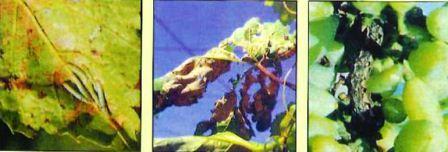
- Parasitoids: Egg: Trichogramma chilonis, Telenomus spp.; Larval: Campoletis chloridae, Peribea orbata, Glipapanteles africanus, Carcelia sp, 6. Ichneumon spp., Cotesia ruficrus, Chelonus carbonator; Pupal: Blepherella setigera, Sarcophaga dux , Sarcophaga albiceps, Brachimeria lasus, Lasiochalcidia erythropoda.
- Predators: Chrysoperla zastrowi sillemi, C. crassinervis, King crow, braconid wasps, dragon flies, spider, praying mantids, Harpactor costalis, Rhynocoris fuscipes, R. squalis , Polistes stigma, Coranus spiniscutis,
Mealybugs
Biology- Egg: These eggs are orange in colour (M. hirsutus) or yellowish white (P. citri). Theyhatch in about 5 days
- Nymph: The first instar nymphs are also called as crawlers, which are mobile.
- They settle on the plants, start sucking the sap and form the colonies.
- Crawlers are orange in colour (M. hirsutus) or yellowish white (P. citri).
- The total nymphal period is 19 days for male and 21 days for female. The male nymph forms a cottony cocoon in which the pupal stage is found mainly in the winter season
- Adult: The adult female mealybugs are pinkish (M. hirsutus) or yellowish white (P. citri) and sparsely covered with white wax. The male and female mealybugs are similar in early stages.
- The female passes through three nymphal instars while male passes through four nymphal instars.
- The adult male has a pair of wings and a pair of halteres. Males are very rare and female mealybugs are commonly found causing the damage in the field.
- Mealybug completes the life cycle in about 30 days. Without mating, they are known to reproduce partheno-genetically throughout the year.
- Nymphs and adult mealybugs suck the sap from the trunk cordons, buds, spurs, aerial roots, leaves, shoots, nodes, flower panicles and bunches.
- Infestation of the growing point especially with the pink mealybug results in malformation of leaves and
- Shoot tips.
- Honeydew excreted by mealybug nymphs and adults, support the growth of sooty mould on leaves, shoots and bunches
- Sooty and sticky bunches harbouring mealybugs and their white cottony wax masses are unfit for marketing as table grapes.
- Raisins cannot be prepared from such infested bunches.
- The pest attack weakens the grownup vines.
- In case of severe mealybug infestation young vines often die.
- The grape mealybug causes losses up to 100 per cent in severe cases in the vineyard.

- Parasitoid: Parasitic wasps,
- Predator: Coccinellid (Cryptolaemus montrouzieri).
Mites
Biology- Egg: Eggs are found on the upper surface of the leaves when the population levels are high. Eggs are also laid in its webbing.
- Freshly laid eggs are minute measuring 0.1 mm white, spherical, transparent and appear like a water droplet.
- Later they change into dull white, gradually turn brown and then become transparent along sides with red spot visible before hatching. The female mite produces 30-50 eggs. Hatching takes place in 4-6 days.
- Nymph: The newly hatched nymphs have translucent larva has six legs. Dark spots appear soon after feeding on the dorsal side.
- The protnymph and deutonymphal stage has eight legs. The deutonymph stage is similar in appearance to an adult female but smaller. Nymphal period is 6-8 days.
- Adult: Freshly emerged adult females are 0.5 mm long and devoid of spots but as the feeding begins, the spots become more distinct. Usually two large, diffuse spots appear forward. Adult spider mite females are reddish. Their pointed abdomens and smaller size easily recognize males. Adult mites live for about 15 days. Breeding is rapid in summer months
- Life cycle completed in 10-14 days depending on weather conditions.
- Both nymphs and adults suck the cell sap from lower surface of tender leaves causing the cells to collapse and die.
- In heavy infestations, the mites remove chlorophyll up to 70% leading into development of brown burnt patches on the infested leaves, which wither and finally dry.
- Discoloration of leaves leads to reduction in photosynthesis thereby affecting the vigour of the plants.
- Severe infestation of spider mites results in delay in maturing and ripening of bunches and reduction in sugar content thereby affecting the quality of grapes.

- Predators: Predatory mites, predatory beetles such as small staphilinids (Oligota spp.), ladybird beetle, lacewing, predatory thrips, anthocorid bug (Orius spp.), mirid bug; Lacanicillium (Verticillium) lecanii, Beauveria spp. (entomo pathogenic fungi).
Thrips
Biology- Egg: Hyaline, globular laid in mass. Eggs are inserted in the tender tissue on the underside of the leaves. Hatching takes place in 8-10 days
- Nymph: Nymphs tiny, slender, fragile and straw yellow in colour. After feeding, nymphs move down to the soil and pupate in the top 8-18 cm. Nymphs are similar to adults but are without wings.
- Adult: Adults with heavily fringed wings. Total life cycle is completed in about 15 days.
- S. dorsalis is found in almost all chilly growing areas. It is a polyphagus pest. Besides chilli, it also infests brinjal, cotton, groundnut, castor, bottlegourd, guava, tea and grapevine. It is more common on un-irrigated chilli crop than irrigated one.
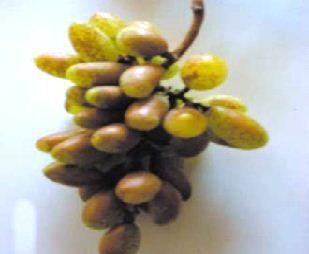 Damage is caused both by nymphs and adults by rasping the lower surface of the leaf with their stylets and sucking the oozing cell sap.
Damage is caused both by nymphs and adults by rasping the lower surface of the leaf with their stylets and sucking the oozing cell sap.- The injured surface is marked by the number of minute spots thereby producing a speckled silvery effect.
- Curling of the leaves is observed in case of heavy incidence.
- The thrips also attack blossoms and developing berries.
- The affected berries develop a corky layer and become brown and fetches low price in the market.
- Predators: Predatory mite (Amblyseius swirskii), predatory thrips (Aeolothirps spp.), anthocorid bug (Orius insidiosus) etc.
Grape leaf folder
Biology- Egg: Eggs are small (about 1/32 inches long), flat, iridescent, elliptical structures laid singly on the underside of a leaf, often in the angles between a vein and the leaf surface.
- Larva: Larvae are 3/4 inch long when fully grown. They are glossy, translucent yellow green on the sides and somewhat darker above, with scattered fine yellow hairs on each segment.
- The head and prothoracic shield are light brown, and there are light brown spots on the sides of the first two thoracic segments. Larvae wiggle vigorously when disturbed and drop to the ground.
- Pupa: Pupae average a little over 1/2 inch long; they are light brown just after pupation, but soon turn dark.
- Adult: The adult is a very dark brown, almost black, moth with a wingspread of about 1 inch. The front wings each have two white spots. The hindwings of the female also have two white spots, while those of the male have only one large white spot. There are two white bands across the abdomen. The male antennae are thickened and distorted in the center; the female antennae are smooth
- A larva is large enough it folds the leaf, exposing the under surface; the edge is held in place by bands of silk thread.
- It is within the protection of this fold that the larva feeds, skeletonizing the leaf of the upper surface.
- When the larvae are numerous the injury to the vine becomes conspicuous, even at a considerable distance, because the light color of the under surface of the folded leaves contrasts boldly with the dark green of the upper side normally presented, thus giving the vine a patchy appearance.
- Larvae roll muscadine leaves, which are thinner than bunch grape leaves.

- Larval parasitoid: Bracon cushmani, Cardiochiles spp
- Predators: Lacewing, spider
Girdle beetle/grape cane girdler:
Biology- Egg: The female hollows out a small cavity in the shoot, places a single egg into it ,and fills the egg cavity with frass. Then she proceeds to girdle the cane at two places: just below the egg cavity and several inches above. The egg is 0.7 mm long, and off-white. It takes about 10 days for the egg to hatch.
- Larva: The fully-grown larva is white with a brown head, legless, and measures 8 mm in length. It burrows in the center of the shoot on either side of the egg cavity larval development takes over a month. The shoot in which the larva feeds either breaks off at the girdled point or dies back to the first node below the egg cavity and drops to the ground
- Pupa: The pupa is light- colored but becomes darker just prior to emergence. Some of the adult features such as legs and snout are already clearly visible in the pupal stage. Development to the adult is completed after about two weeks.
- Adult: The shiny-black adults are small, 3 mm long weevils with a characteristic curved snout. Except for their color they resemble the reddish-brown adults of the grape cane gallmaker, Ampeloglypter sesostris. The adult beetles emerge from infested canes during August and subsequently overwinter in trash on the ground.
- In May of the following year the adults leave their over wintering sites. When grape shoots are 30 to 50 cm long, usually in late May before grape bloom, the female begins to lay her eggs and girdle new canes.
- Egg-laying continues for about one month.
- The girdling by the female causes the terminal growth of the new shoots to bend over above the upper girdle and drop to the ground
- Later the whole infested shoot dies back to the lower girdle and falls from the vine Vines 'pruned' by the grape cane girdler have a ragged appearance suggesting serious injury to the plant.
- Girdling of the terminal growth has little or no effect on the crop unless fruit-producing nodes are close to attacked shoot tips.

Flea beetle
Biology- Egg: Yellow to orange, cylindrical in shape, rounded on 1end and 1mm in length and 0.4 mm in width. Eggs are laid near the buds or loose cane.
- Larva: Newly hatched larvae is dark brown in colour but late turns light brown, 7-9 mm in length, and whole body is cover with back shiny and rectangular plates of varius sizes which gives the spotted appearance of larvae
- Pupa: Pupae bright yellow, 4-6 mm long, and with consipicous reddish brown eyes. Wings and legs are off white colour.
- Adult: Adults are oval in shape, metallic shining blue, and 4-5 mm in length. The antennae are thread like. The thighs of hind legs are enlarge and enabling the adult to jump quickly when disturbed.
- The adult beetles scrap the sprouting buds after each pruning.
- Damaged buds fail to sprout. The beetles also feed on tender shoots and leaves, and tendrils causing substantial damage.
- The tender shoots may wither and drop down. The losses are heavy when the sprouting buds are damaged after forward pruning.
- Damage is caused by adult beetles feeding on primary buds, which prevents them from developing into shoots, thus resulting in a decreased yield.
- The greatest economic loss occurs when beetles feed on buds from “bud swell” until the “first leaf separates from the shoot tip” stages.
- Once shoot growth reaches 7 cm, damage caused by the grape flea beetle normally does not affect yield.
- Although primary damage is caused by adult flea beetle to the developing buds, larval damage can also occur on the foliage and is typically limited to several leaves and vines.
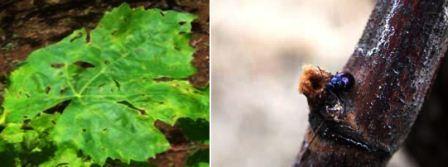
Rose chafer beetle
Biology- Egg: chafer needs sandy soil to lay eggs, plants on sandy sites are most likely to be infested. It feeds on plant material for 3 to 4 weeks, lays eggs in the soil, and then dies soon afterwards.
- Grub: The eggs hatch in 1 to 2 weeks, and the small white grubs feed on the roots of grasses and weeds. The rose chafer overwinters as larvae in the soil.
- Adult: The adult chafer is pale green to tan color, slender, approximately ½ inch long, with a reddish head and long, spiny, reddish brown legs.

Grapevine stem borer
Biology- Egg: Capsule shaped eggs are laid singly in each of the slits and the slits are covered with a hard gummy substance.
- Larva: Newly hatched flat-headed cream coloured grubs burrow into the trunk or arms and feed inside and make them hollow.
- Pupa: Larvae pupate within 3-5 days, dark brown in colour.
- Adult: An adult beetle is about 4 cm long and dull yellow with minute spots. They remain inside the vine up to May. Thereafter, they pupate inside the tunnel made in the vine. The insect is a borer, the grub of which bores in to stem and branches and causes drying and withering of affected branches.
- The adult beetles start emerging from the vines during July to September by making a round hole on the vine. Female beetles make conspicuous slits on the bark of the trunk and arms of the vine.

- Presence of saw dust like substance under the vine indicates the damage done by the grub. Damaged vines get weakened and growth gets affected.
- The maturity of berries is also delayed which ultimately affects the grape production in terms of both yield and quality.
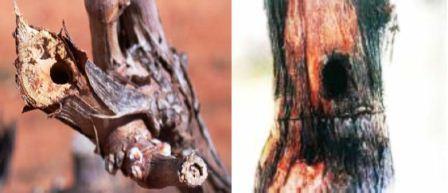
- Predators: Lacewing, coccinellids, King crow, dragon fly, spider, robber fly, praying mantis , Ovomermis albicans, a nematode.
Root-knot nematode
Biology- Most species of plant parasitic nematodes have a relatively simple life cycle consisting of the egg, four larval stages and the adult male and female.
- Development of the first stage larvae occurs within the egg where the first molt occurs. Second stage larvae hatch from eggs to find and infect plant roots or in some cases foliar tissues.
- Under suitable environmental conditions, the eggs hatch and new larvae emerge to complete the life cycle within 4 to 8 weeks depending on temperature.
- Nematode development is generally most rapid within an optimal soil temperature range of 70 to 80°F.
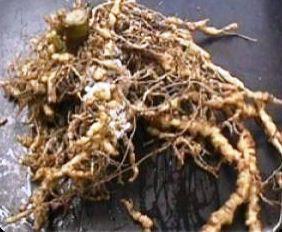 Infected plants in patches in the field
Infected plants in patches in the field- Formation of galls on host root system is the primary symptom
- Roots branch profusely starting from the gall tissue causing a „beard root‟ symptom
- Infected roots become knobby and knotty
- In severely infected plants the root system is reduced and the rootlets are almost completely absent. The roots are seriously hampered in their function of uptake and transport of water and nutrients
- Plants wilt during the hot part of day, especially under dry conditions and are often stunted
- Nematode infection predisposes plants to fungal and bacterial root pathogens
- Primary: Egg masses in infected plant debris and soil or collateral and other hosts like Solonaceous, Malvaceous and Leguminaceous plants act as sources of inoculums.
- Secondary: Autonomous second stage juveniles that may also be water dispersed.
- Loamy light soils.
IPM for Grapes
To know the IPM practices for Grapes, click here.
Source: NIPHM and Directorate of Plant Protection, Quarantine & Storage
Last Modified : 2/13/2020
© C–DAC.All content appearing on the vikaspedia portal is through collaborative effort of vikaspedia and its partners.We encourage you to use and share the content in a respectful and fair manner. Please leave all source links intact and adhere to applicable copyright and intellectual property guidelines and laws.
RELATED ITEMS
Cumin: Insect and Nematode Pests Management
This topic covers the information related to Insec...
Loquat Insect Pests
This topic provides information about Loquat Inse...
Blackgram & Greengram: Insect, Mite and Nematode Pests Management
This topic covers the information related to Insec...
Black Pepper: Insect and Nematode Pests Management
This topic covers the information related to Insec...
